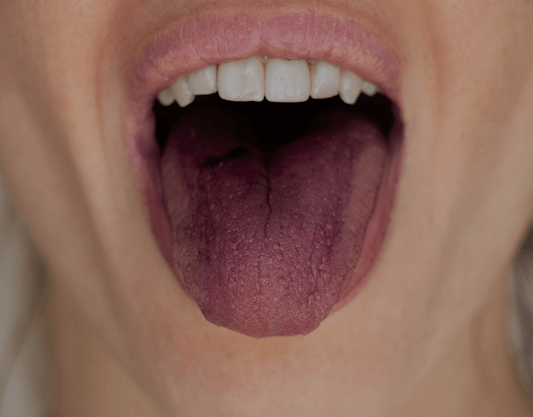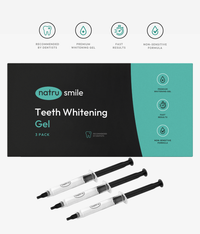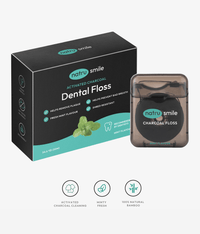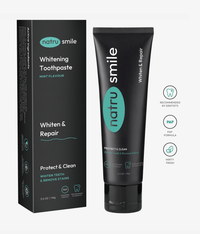
All products are certified by dental expert Dr. Greg Grillo
When your tongue changes from its normal pink color to something completely different, you're right to be concerned. But just like a black tongue (which is completely harmless), you don't need to worry about a purple-colored tongue right away.
While a purple tongue can be a sign of serious medical issues, it's usually a symptom of something benign and treatable.
In this article, we'll show you all the possible causes and treatments for a purple tongue so you can better understand the condition and seek medical attention when necessary.
Purple Tongue: A Quick Overview
A purple tongue is a condition where the tongue changes color from its normal pink hue to a bluish or purple shade.
If your tongue turns purple, it indicates a change in your body. This change could be the result of dehydration, dietary changes, nutrient deficiencies, allergies, infection, or (in rare cases) more serious medical conditions.
Usually, this is a circulation problem—when your blood doesn't have enough oxygen, it turns blue or purple. Recent research points to the possibility of a purple tongue being related to fatigue as well.
Naturally, blood in your body is red (although your veins may appear blue due to light refraction). If your tongue has an excessively purple color, it's usually because the blood vessels in your tongue are inflamed, injured, or blocked.
Causes Of A Purple Tongue
Several factors can cause a purple tongue, but they mostly revolve around your body's inability to circulate blood properly.
Blood Circulation Problems
Blood circulation describes how quickly and efficiently your blood is moving throughout your body. As blood reaches the capillaries (i.e., the smallest blood vessels in your body), it can cause those areas to turn purple or blue.
When your circulation is impaired, it can restrict the amount of oxygen-rich blood reaching your tissues and organs. This causes those areas (including your tongue) to take on a purple tint.
According to Healthline, the most common causes of poor blood circulation include:
- Obesity
- Heart conditions (e.g., high blood pressure or coronary artery disease)
- Vascular diseases
- Arterial problems
- Diabetes
Typically, people experience reduced blood flow in their extremities, such as their hands or feet. But poor circulation can also reflect itself in your mouth, causing a tingling tongue and purple color.
Vitamin B-2 Deficiency
Vitamin B-2, more commonly known as riboflavin, is an essential water-soluble vitamin that can be found in a range of dietary supplements and food sources. It plays a key role in energy metabolism, helping to convert food into fuel for the body. It also helps support healthy skin, vision, and nervous system health.
Vitamin B-2 deficiency is most commonly found in adults over the age of 50 and people with gastrointestinal diseases (such as celiac disease). Since it is most commonly found in meat, fish, eggs, and dairy, vegans and vegetarians are also at higher risk of this deficiency.
Vitamin B-2 deficiency causes changes in skin, nails, and inner membranes, as well as fatigue. It can also lead to mouth sores and a purple tongue due to impaired circulation.
Bacteria Growth
Just like certain foods, bacteria can also cause changes in your tongue's color. If you don't brush or floss your teeth properly, bacteria and plaque can build up in your mouth. If left untreated, this buildup can lead to infections that change the color of your tongue from the usual pinkish hue.
If you have canker sores or a tongue ulcer, you might also notice a purplish color around the affected area, although this can be a different color as well.
Addison’s Disease
Addison's disease, also known as primary adrenal insufficiency, is a rare endocrine disorder caused by the body's inability to produce enough of the hormones cortisol and aldosterone. This can occur when the adrenal glands (located on top of each kidney) become damaged or weakened, which can be caused by any number of factors.
Addison's disease can cause a range of symptoms, including changes in skin color (from tan to dark brown). In the same way it changes your skin color, it can also change your tongue’s color from impaired circulation.
Varicose Veins
Varicose veins are a condition that affects many adults, particularly those over the age of 40. Varicose veins occur when blood vessels become enlarged and twisted, often due to faulty valves in the blood vessel walls.
The primary symptom of varicose veins is a purple or blue discoloration in the affected area. This discoloration can also affect your tongue if the blood vessels in your mouth are affected.
Oral Herpes
Oral herpes typically manifests itself on the exterior of your mouth. During a flare-up of HSV (herpes simplex virus), you’ll usually get cold sores around your lips and outer areas of your mouth.
Herpes on the tongue, however, will show up as purple spots on your tongue. They are usually risen and will affect its texture in addition to its color.
Diet And Lifestyle
Your diet and lifestyle can also be contributing factors to a purple-colored tongue. Too much caffeine, alcohol, or smoking can cause poor circulation in your body, which can be reflected on your tongue.
Usually, your diet will reflect color changes in other parts of your body first, especially if you consume these substances in moderation. But you can burn your tongue from smoking and consuming hot beverages, which might cause a purple tongue temporarily.
As mentioned above, your tongue can change color as a result of vitamin B-2 deficiency as well. Since this is directly linked to your dietary choices, this is another way your diet plays a role in the color of your tongue.
How you live your everyday life can also impact your blood circulation and, therefore, the color of your tongue. A sedentary lifestyle can contribute to poor circulation, which can result in discoloration throughout your body.
Heart Problems
Poor circulation is often caused by the heart's inability to pump blood properly. This can be due to a weakened heart or other conditions like high blood pressure or an enlarged heart.
If your body has difficulty circulating blood, your extremities and other parts of your body will feel the effects. This can turn your tongue purple and is often accompanied by other signs and symptoms of heart problems.
Tumors
Tumors are the most rare (and also most serious) cause of a purple tongue.
Tumors can arise in the mouth, throat, or anywhere along the digestive tract and can lead to changes in color on your tongue.
A tumor in your mouth might look like spots on your tongue, complete discoloration, or additional lumps or veins. If you notice any of these changes, it's important to seek medical advice as soon as possible, even if you don't notice any pain.
Increased Platelet Count
Platelets are small, disc-shaped cells in the blood. They work by sticking together and forming a type of web or mesh to plug up any holes or tears in the blood vessels during injuries. Platelets help to prevent excessive bleeding by releasing chemicals that aid in the formation of clots.
Since they help form clots outside your body, an increased number of platelets can also cause unwanted clotting inside your body. That's why an increased platelet count is directly associated with a purple tongue—when a clot forms in the area, circulation is limited and the lack of oxygen turns your tongue purple.
Low Oxygen
As we mentioned earlier, oxygen is what keeps your blood red. Your insides are mostly pink-colored because of the oxygen in your blood. A lack of oxygen can cause discoloration throughout your body, including your tongue.
This can happen if you are exposed to high levels of pollutants or secondhand smoke. It can also occur if you have anemia or any other medical condition that affects how much oxygen is present in your bloodstream.
Osler-Weber-Rendu Disease
Osler-Weber-Rendu (OWR) Disease, also known as Hereditary Hemorrhagic Telangiectasia (HHT), is a genetic disorder that affects the vascular system. It is characterized by abnormal blood vessel growth in the lungs, nose, mouth, and skin.
The abnormal vessels can cause nosebleeds, coughing up of blood, and even change in your tongue's color due to impaired circulation.
Is Purple Tongue A Sign Of Cancer?
Although a purple tongue is a common symptom of a tumor in the area, it isn't necessarily a sign of mouth cancer. Usually, a purple tongue is the result of a circulation issue.
When inspecting your discolored tongue, look closely for other signs of a tumor, such as red or white spots, lumps, or ulcers. If you notice any of these changes in your mouth, it's important to consult with a doctor immediately to rule out the possibility of cancer.
When To Visit A Doctor For Purple Tongue
Since purple tongue might be the result of something you can fix on your own, you might be inclined to wait it out before visiting a doctor. However, seeing one right away is the best way to diagnose the problem.
If you notice any of these problems, visit a doctor as soon as possible:
- Poor circulation, tingling, and purple coloration in your extremities in addition to your tongue
- Pain in your mouth, throat, or tongue that won't go away
- Discoloration or spots on your tongue that don't change with time
- Any changes in the texture of your tongue
- Changes in the size of your tongue
Just like a yellow tongue or a black tongue, a purple tongue is not usually an emergency situation. But you need to visit your doctor as soon as possible if you want to rule out the potential for one.
Purple Tongue Treatment Options
Your purple tongue prognosis will vary wildly depending on what the actual cause of it is. If it is the result of a blood circulation problem (which it most likely is), treatment will probably look something like this:
- Lifestyle changes. Making small lifestyle changes to improve your circulation, such as avoiding smoking and alcohol, exercising regularly, eating a healthy diet, and taking supplements that promote blood flow.
- Dietary changes. Eating more foods that are rich in folic acid, B12, and iron can help improve your body's circulation.
- Increased focus on oral hygiene. Using tongue scrapers or additional cleaning methods around your mouth can reduce bacteria buildup and help you heal your condition more quickly.
- Medications. If the cause of your purple tongue is an underlying medical condition or infection, your doctor may prescribe medications to help treat it.
- Surgery or procedures. In rare cases where the cause of your purple tongue is a tumor or other abnormal growth, surgery may be necessary to remove it.
How To Treat And Prevent Purple Tongue
A purple tongue is certainly reversible and preventable. All it takes are a few simple lifestyle changes and the right medications (if needed).
Start by reducing your exposure to environmental pollutants or secondhand smoke. Make sure you're getting enough oxygen through deep breathing exercises or activities such as swimming, running, or biking. Try to eat more iron-rich foods and take supplements that help promote healthy circulation.
Taking additional steps to clean your tongue properly will also help you protect yourself from bacteria growth, a potential cause of your tongue discoloration.
If your condition isn't the result of a circulation problem, you might not be able to prevent it. Tumors, for example, can appear in anyone. Still, limiting exposure to vape, cigarette, and marijuana smoke, tobacco products, and alcohol can minimize your risk of developing one.
Want to learn more? These are the questions our customers ask us the most.
Is It Normal For Your Tongue To Be Purple Underneath?
Since there are many veins underneath the tongue, it can appear purple. This is normal, but if your tongue is consistently discolored throughout, you might have a problem with your blood circulation. Pay close attention to the rest of your body (particularly your extremities) to see if you have poor circulation.
What Disease Causes Purple Tongue?
Several diseases can cause your tongue to turn purple, including anemia, dehydration, vitamin B-2 deficiency, diabetes, and cancer. Rare conditions like Addison's disease can also cause this discoloration.
Does COVID Make Your Tongue Purple?
According to clinical research of COVID-19 patients, those diagnosed with mild or moderate symptoms showed a light red tongue and white coating. Severe cases displayed purple tongues with yellow coatings, while 75% of critical patients had tender tongues. Additionally, a greasy coating was found to be one of the most distinguishing characteristics among those suffering from this illness.
Is Purple Tongue Serious?
It depends on the cause of your purple tongue. In most cases, it's not a serious condition and can be reversed with lifestyle changes or proper treatment. But if it is caused by an underlying medical condition such as cancer (which will usually have additional side effects), it could be more serious and require further investigation.
Can Your Tongue Turn Purple?
Your tongue can turn purple from a variety of causes, including poor circulation, anemia, vitamin deficiencies, dehydration, and even cancer. For a proper diagnosis, it is best to consult with your doctor. They will be able to help you determine the cause of your purple tongue and suggest the appropriate treatment.
Why Is The Bottom Of My Mouth Purple?
The bottom of your mouth is naturally purple because of the veins underneath the tongue. But there is usually only part of the tongue that appears purple. If it has spread to other areas and you don't have any underlying medical conditions, there may be an issue with your blood circulation.










